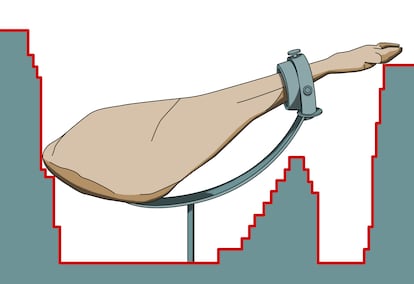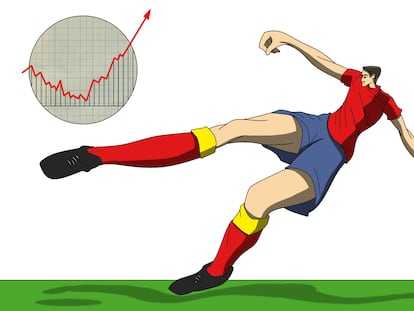Regime change in the economy
Let us not forget that a world with positive interest rates and inflation is better than a world with zero interest rates and inflation

We say in Spain that when you turn 50 (age is more a mental than a physical state, but that’s another story) you “turn the ham to the other side.” For many people it is a regime change, which leads to a different approach to life, to focusing on different problems, with sometimes radical changes in behavior, for better or worse. In the economy, and in the markets, there are similar moments. Sometimes generational changes occur, what previously mattered takes a backseat, markets change behavior, and economic policy objectives shift.
The rapid rise in long-term interest rates observed since the summer has some elements of such generational change. In some respects, it seems as if the markets have returned to the period before the 2007 financial crisis. Let’s refresh our memory a little.
At that time, markets priced that inflation was well anchored at 2%, and assigned a negligible probability to everything that happened during the subsequent decades: that central banks would lower rates to zero, commit to keeping them at zero as long as it was necessary, or buy government bonds for years. It is true that there had been some debate about it: in 2002 Alan Greenspan mentioned the risk of “corrosive deflation” and discussed economic policy alternatives, and Ben Bernanke, then a Fed Governor, gave a speech titled “Deflation: Making Sure ‘It’ Doesn’t happen here.” In fact, the Federal Reserve lowered rates to 1% in 2003 to minimize the probability that inflation could reach zero. It is also true that Japan had been mired in deflation for some time, with zero interest rates, and buying, very timidly compared to what central bankers did later, government bonds. But nobody then believed that this was possible in the West; it was considered an exotic case stemming from the poor economic management of the Japanese authorities.
Back then, markets also believed that the equilibrium interest rate was high. For the U.S., the consensus was that the interest rate that closed the output gap and set inflation at target was around 4-4.25%, which created enough room to lower interest rates in case of need — but also created an expected future range for interest rates around that level. Markets can remember, and in 2000 the Fed had raised rates to 6.5%. That is why it is not surprising that, in 2006, markets priced that, five years later (that is, in 2011), the short-term interest rate would be around 5%. Something that did not happen, because in 2011 rates had fallen to zero, but that is another story.
The current pattern of long-term interest rates implies a return to that period before the 2007 crisis. Markets price that, over the next decade, inflation will be well anchored at 2%, the equilibrium interest rate will be positive, and central banks will no longer cut rates to zero or buy bonds. For example, markets price that, in five years (that is, in 2028), the short-term interest rate in the U.S. will be around 4.5%. Markets seem to have closed the deflationary period.
Why this regime change? It’s difficult to pinpoint a single factor, but there are several clues. On the one hand, the challenging fiscal situation in the U.S., with a budget deficit of 6% of GDP and low expectations of reducing it given its institutional instability and the fragility of its budgetary process. The prospects of large deficits — the Congressional Budget Office projects deficits above 5% of GDP over the next three decades — has increased the risk premium on long-term bonds. Because the law of supply and demand also applies to government debt: given the expected abundant supply of public debt to finance these deficits, investors demand a lower price (which implies a higher interest rate) to buy it.
On the other hand, the expectation that Japan could abandon the zero interest rate regime after almost four decades (with a very brief interval in 2005-06 when rates rose to 0.5%). Japanese investors are major buyers of global government debt, and a rise in interest rates in Japan to 1 or 2% would therefore change the pricing structure of government bonds globally. It is also increasingly evident that the world economy is more resistant to interest rates than previously thought. After a very aggressive increase in interest rates, and despite an unprecedented energy shock, the world economy shows the best labor market in recent decades: according to OECD data, the employment rate of the G7 countries is the highest in history.
There are other factors, perhaps more speculative. For example, that in the future supply shocks will be dominant and inflation more volatile, due for example to climate change and geopolitical uncertainty, and that therefore bonds will be less useful as a hedging instrument for investment portfolios — as inflationary shocks increase the probability that interest rates will rise and stock prices will fall at the same time. And if bonds are less useful as a hedging instrument, their price should be lower — that is, their interest rate should be higher. It is also true that stock markets have resisted rising interest rates well, suggesting that perhaps the rise in interest rates reflects, in part, better medium-term growth prospects.
Journalism is always the first draft of history. It is possible that, in a few years, we will look back and conclude that the cumulative effect of the reforms and policies developed in response to the 2007 financial crisis, the euro crisis, the pandemic, and the rapid increases in energy prices, served to improve economic policy frameworks, restore the health of the world economy, and close the deflationary cycle that began in 2007. Let us not forget that a world with positive interest rates and inflation is better than a world with zero interest rates and inflation. Just as many people reach their prime when they reach their fifth decade and “turn the ham to the other side,” it is possible that the economy in coming decades will be brighter than that of the previous two decades. Let’s celebrate it, and take advantage of the opportunities.
Sign up for our weekly newsletter to get more English-language news coverage from EL PAÍS USA Edition
Tu suscripción se está usando en otro dispositivo
¿Quieres añadir otro usuario a tu suscripción?
Si continúas leyendo en este dispositivo, no se podrá leer en el otro.
FlechaTu suscripción se está usando en otro dispositivo y solo puedes acceder a EL PAÍS desde un dispositivo a la vez.
Si quieres compartir tu cuenta, cambia tu suscripción a la modalidad Premium, así podrás añadir otro usuario. Cada uno accederá con su propia cuenta de email, lo que os permitirá personalizar vuestra experiencia en EL PAÍS.
¿Tienes una suscripción de empresa? Accede aquí para contratar más cuentas.
En el caso de no saber quién está usando tu cuenta, te recomendamos cambiar tu contraseña aquí.
Si decides continuar compartiendo tu cuenta, este mensaje se mostrará en tu dispositivo y en el de la otra persona que está usando tu cuenta de forma indefinida, afectando a tu experiencia de lectura. Puedes consultar aquí los términos y condiciones de la suscripción digital.
More information
Archived In
Últimas noticias
Maduro pleads not guilty before the federal court in New York: ‘I am still the president of Venezuela’
A new test can detect Alzheimer’s from a finger prick
UN team enters Sudanese city of El Fasher after paramilitary massacre: ‘It’s like a ghost town’
A recipe for resistance: Indigenous peoples politicize their struggles from the kitchen
Most viewed
- Gilles Lipovetsky: ‘If you want to live better and fall in love, take Prozac, don’t look to philosophy’
- Alain Aspect, Nobel laureate in physics: ‘Einstein was so smart that he would have had to recognize quantum entanglement’
- Alvin Hellerstein, a 92-year-old judge appointed by Bill Clinton, to preside over Maduro’s trial in New York
- Why oil has been at the center of Venezuela-US conflicts for decades
- Maduro’s downfall puts China’s relationship with Venezuela to the test











































